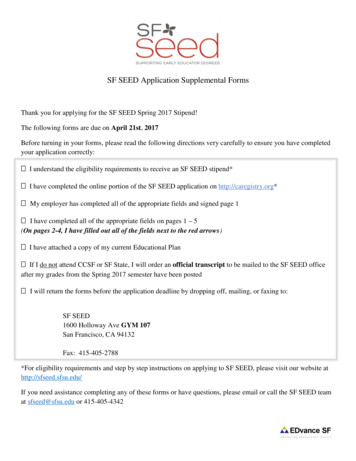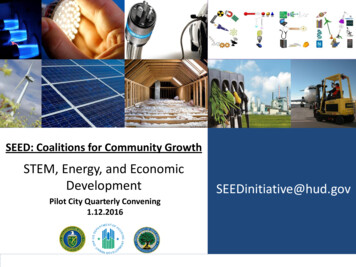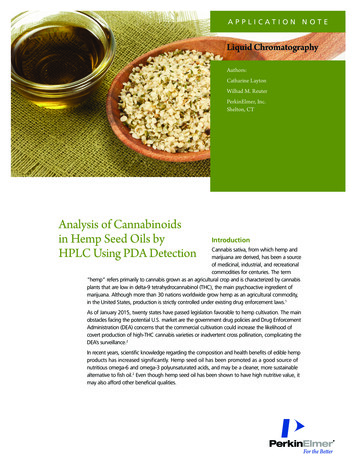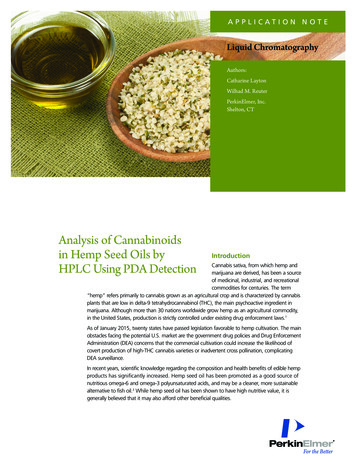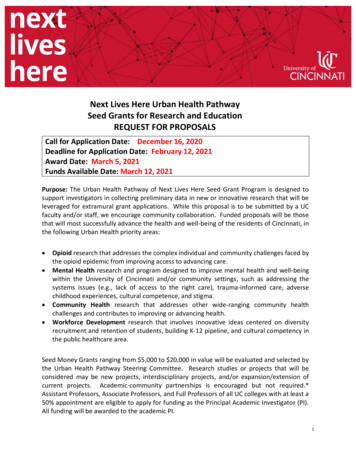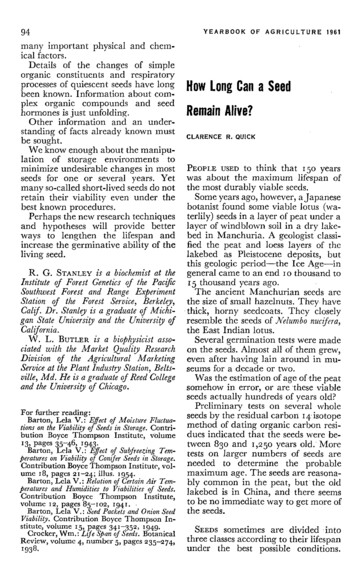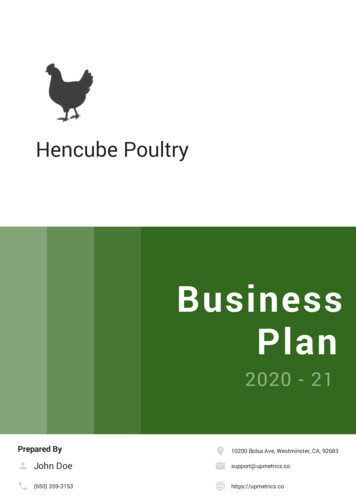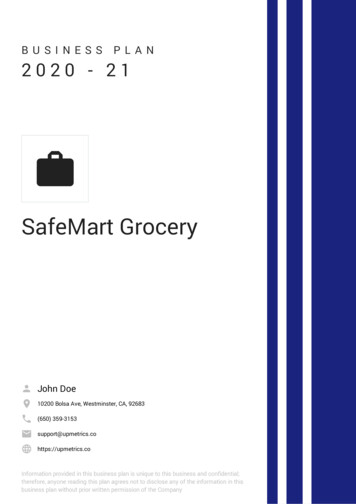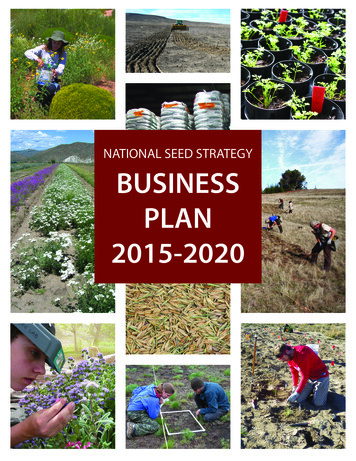
Transcription
NATIONAL SEED STRATEGYBUSINESSPLAN2015-2020
AcknowledgementsThe National Seed Strategy Business Plan team would like to thank the following people fortheir time and willingness to share their knowledge during the development of thisdocument:Patricia DeAngelis, USFWSAmy Bartow, USDA NRCSJerry Bensen, BFI Native SeedsKas Dumroese, USDA FSGreg Eckert, NPSFred Edwards, BLMVicky Erickson, USDA FSMegan Haidet, Chicago Botanic GardenAnne Halford, BLMHealy Hamilton, NatureServeKay Havens, Chicago Botanic GardenKayla Herriman, USDA FSKen Holsinger, BLMR.C. Johnson, USDA ARSTom Kaye, Institute for Applied EcologyFrancis Kilkenny, USDA FSAndrea Kramer, Chicago Botanic GardenSarah Kulpa, USFWSOlivia Kwong, Plant Conservation AllianceChristina Lund, BLMZoe Miller, BLMMark Mousseaux, BLMAdrienne Pilmanis, BLMGreg Schundler, Earth EconomicsElizabeth Sellers, USGSNancy Shaw, USDA FS (retired)Clint Shock, Oregon State UniversityBrad St. Clair, USDA FSWendy Velman, BLMTroy Wood, USGSWriting TeamPeggy Olwell, BLM Plant Conservation Program LeadSteven Bosak, Tenworth Advisors
Table of ContentsIntroduction1The National Seed Strategy Goals, Objectives, and Actions with Costs2Goal One: Identify Seed Needs and Ensure the Reliable Availability of Genetically Appropriate Seed 2Goal Two: Identify research needs and conduct research to provide genetically appropriate seed,and to improve technology for native seed production and ecosystem restoration5Goal Three: Develop Tools that Enable Mangers to Make Timely, Informed Seeding Decisions forEcological Restoration10Goal Four: Develop Strategies for Internal and External Communications14Conclusion16Addendum: Action Cost Estimate Table17
IntroductionThe “National Seed Strategy for Rehabilitation and Restoration 2015-2020” (Strategy) waslaunched on August 17, 2015 in Boise, ID. The Strategy was written to address seed needsacross the country. A broad coalition of Federal agencies and non-Federal organizationsdeveloped the Strategy to provide guidance on increasing the supply of geneticallyappropriate seed and improving the use of native plant species for stabilization,rehabilitation, and restoration treatments on Federal and privately-owned land. TheStrategy also presents specific seed research actions that can rely on public-privatepartnerships to improve the seed supply for rehabilitation and restoration. While theStrategy will be renewed in 5-year cycles, its actions will affect landscapes and habitats farinto the future.The National Seed Strategy Draft Business Plan (Business Plan) is a working document thatdemonstrates the Strategy’s implementation costs to top policymakers, Plant ConservationAlliance (PCA) partners, and the public. It was developed through consultation with staffand researchers at the Agricultural Research Service, Bureau of Land Management, U.S.Forest Service, National Park Service, Natural Resource Conservation Service, U.S. Fish andWildlife Service, U.S. Geological Survey, Non-Government organizations, and Universities,together with experts at Botanic Gardens and private seed companies. The plan’s intent isto help agencies and partners better direct existing financial resources – and work tosecure additional funding – to implement the Strategy. The Business Plan is a companiondocument to the Strategy and must be viewed alongside the Strategy. The Business Plan isnot a plan to develop a seed business run by the Federal government, but a plan toencourage private sector cooperation and participation.The Strategy has four broad goals covering (1) the assessment of current seed resourcesand needs; (2) research to improve seed availability and restoration success; (3) thedevelopment of restoration and seeding tools for land managers; and (4) strategies forinternal and external communication of seed and restoration issues. Layered within thesefour goals are a series of 14 objectives with 50 discreet actions. The Business Plan followsthe Strategy’s format, breaking cost estimates down by goals and objectives and explainingindividual actions in detail.The Business Plan’s cost estimates for specific actions were formulated with theassumption that, as a national initiative, the Strategy would require implementation acrossthe whole U.S. The final cost of the Strategy will depend on the scope and scale ofimplementation for each action. For many actions, the Business Plan provides a breakdown of cost drivers so that managers can understand the price of up-scaling or downscaling implementation.As of this draft’s printing, no agency or organization has committed to implementing aspecific Strategy action; therefore this document is not an implementation plan. A series offacilitated workshops with all PCA Federal partners (under Objective 4.2) will be a criticalstep towards coordinating implementation and securing agency commitments to theStrategy. The agreements and information that results from those workshops will beincorporated into the final business plan.1
The National Seed Strategy Goals, Objectives, and Actions with CostsThis section lists costs for implementation of the Strategy over a five-year period andprovides detail on the major investments necessary for plant materials development andresearch. Cost estimates are presented by goal, by objective, and by action. Theaddendum provides a summary table of all cost estimates.Goal One: Identify Seed Needs and Ensure the Reliable Availability of GeneticallyAppropriate SeedCost Estimate: 131.85 millionGoal One has three objectives that encompass a total of 13 separate actions; all of theseactions start in the first two years of Strategy implementation. While collaboration withthe private sector and state and local governments will be necessary, most Goal One actionsshould be funded and led by Federal agencies.The major cost associated with this goal is increasing the availability of geneticallyappropriate seed, through seed collections and grow-outs. Agencies do have funds for seedprocurement now, but expanding the list of available (species and quantities) will be costly,especially when bringing new species into production. Many forbs will require more thanone year of growth before any seed is produced, thus their costs will always be relativelymore expensive when compared to the cost of many exotic and native grasses.Objective 1.1: Assess the Seed Needs of Federal Agencies and the Capacity of Private andFederal ProducersCost Estimate: 1.85 millionAction 1.1.1 will assess the seed needs of the 12 PCA-member Federal agencies, includingthe need for pollinator-friendly plant materials and the need for seeds on a bioregionalbasis.Action 1.1.2. is an inventory of Federal and private seed collections, production, andstorage capacity as well as identification of all Federal guidance for seed collection andproduction. This will include a review of Federal databases and reporting systems used totrack seed inventory and use.Action 1.1.3 is to identify existing Federal seed and restoration policies and guidance.Action 1.1.4 and 1.1.5 include analyses of the needs and capacity assessments resultingfrom actions 1.1.1 and 1.2.1.Since all Objective 1.1 actions focus on an assessment of seed need, seed collections, andseed storage and production capacity, the business plan recommends addressing theseactions with a single contract or agreement with an independent third-party. Entrustingthese assessments and analyses to a single, independent entity with experience in this typeof data collection will provide an unbiased, comprehensive view of all information relatedto seed supply and use. Moreover, it will lend credibility to the effort and will likely resultin a higher quality product than an effort led in-house by one of the PCA agencies.2
(Additionally, the business plan recommends including action 2.1.1 in the contract withwhatever third-party is hired. See below for more detail).The cost estimate for this objective, 1.85 million over two years, will cover a team ofexperts and data collectors developing and administering the assessment of all 12 FederalPCA agencies over a two-year period. It also encompasses some Federal staff costs forworking with the third-party contractor to develop the assessment and manage thecontract.Objective 1.2 : Assess Capacity and Needs of More than 20 tribes, 50 states, more than 300Private Sector Seed Producers, Nurseries, and Other PartnersCost Estimate: 1.30 millionAction 1.2.1 is the assessment of state, local, tribal, private and non-profit seed storage anddistribution facilities. As recommended under Objective 1.1, one method of carrying outprojects such as the needs and capacity assessments would be to engage a third-party toconduct an assessment. The assessment under this action could be included with theassessment called for under Objective 1.1 and run by an independent third-party. Thebusiness plan estimates this action will cost 400,000 in year one and 300,000 in yeartwo.Action 1.2.2 is to work collaboratively with private seed producers and other partners toimprove the distribution of native seed. This action will occur after the assessment iscompleted for action 1.2.1. The cost for this action ( 200,000 in year one and 150,000year two) will cover expenses for meetings among Federal land managers, non-profitpartners, and private seed industry leaders to discuss ways to transform the Federal seedpurchasing to address challenges identified in the assessments. This discussion couldexplore how to expand seed production funding through advance contracting and how toencourage speculative seed production. This funding estimate will also cover the cost of agraduate student exploring the seed industry market and economics, which will helpinform the discussion of how to improve availability of native seed.Action 1.2.3 is to analyze results of non-Federal needs and capacity assessment todetermine if current seed collections, as well as storage and production facilities, meetrestoration needs. The business plan estimates this will cost 250,000 in year two. Thisaction could also be included under a contract with a third-partyObjective 1.3: Increase the supply and availability of genetically appropriate seedCost Estimate: 128.70 millionThe result of the assessments (from Objectives 1.1. and 1.2) will greatly impact theestimated costs of the actions within 1.3.Action 1.3.1 is to expand and improve facilities and plant production capacity. This actionpresumes a need that may or may not be confirmed by the assessments mentioned above.In year one, agencies could invest in increasing seed for 100 grass species and 100 forbspecies. The seeds produced in these grow-outs will be stored in government seed3
warehouses. At 10,000 per acre for grasses with five-acre plots per species and 12,000per acre for forbs with two-acre plot per forb species, the total annual cost will come to 7.4 million.If the need for additional or improved seed storage is necessary, the business planestimates the minimum capital cost for a new, large facility at 10 million, as indicated inyears two, through five. Should the assessment indicate that current storage space issufficient or that a network of smaller seed storage facilities is needed, these costs could beadjusted accordingly. This is an area where collaboration with state and local governmentsthat store seed would be beneficial. The total estimate as it stands now is 77 million overfive years.Action 1.3.2 will improve agency and partner capability to plan for seed needs by seedzone. An annual cost of 150,000 will pay for a graduate student, as well as plantecologists and procurement staff, to work with existing seed banking networks to find waysto coordinate multiagency seed sharing and, perhaps, create a national online database forsource-identified seed. The total two-year cost is 300,000.Action 1.3.3 aims to increase the supply of shrub seed through alternative methods. Thisaction will include a review of regulations that control establishment of shrub seedreserves or planted shrub seed orchards on wildland sites (permitting, contracting, etc).Such reserves and orchards could also be established by private land owners and seedgrowers. The business plan estimates 100,000 in year one to pay for a review of existingresearch and regulations on alternative production methods. In year two and onward, theplan predicts a 250,000 annual cost to test alternative production methods in the field.The total cost over five years is 1.1 million.In order to increase the supply of native seed, agencies need to expand wildland seedcollection and conservation. Action 1.3.4 makes an investment in seed collection programsand would be spread among multiple agencies and non-Federal partners. For 10 millionannually, the business plan estimates that agencies and partners would be able to makemore than 5500 native seed collections a year. (In order to perform some of the researchactions in the Strategy, scientists may need as many as 100 collections of the same taxa).This cost also covers intern training and employment, seed cleaning, seed collectionmanagement, herbarium management, and seed storage.Action 1.3.5 is to engage Federal procurement specialists to assess current contractingregulations and practices so that agencies can identify strengths and address challenges.The aim is to improve Federal agencies ability to purchase the appropriate seed so it can beavailable when needed. The cost estimated under this action ( 150,000 in years two andthree) is to pay for meetings with Federal procurement staff, field staff who need to buyseed, and seed industry representatives.4
Goal Two: Identify research needs and conduct research to provide geneticallyappropriate seed, and to improve technology for native seed production andecosystem restorationCost Estimate: 197.21 millionThe goal has four objectives with a total of 12 separate actions that require substantialinvestment in field and laboratory research. All actions commence in year one and willadvance the science and practice of restoration and land management.Objective 2.1: Characterize Genetic Variation of Restoration Species to Delineate SeedZones, and Provide Seed Transfer Guidelines for Current and Projected FutureEnvironmental ConditionsCost Estimate: 72.50 millionThe two actions under this goal will help land managers select genetically appropriate seedand plant materials for restoration and predict climate change effects on plantdistributions.Action 2.1.1 is to conduct genetic research to develop species-specific seed zones for nativeseeds. Species required for restoration will be identified on an eco-regional basis duringthe assessment under Goal One. Common widespread “workhorse” species will be selectedfrom this list for development of species-specific seed zones. Prioritization will be basedon restoration need as well as genetic, breeding system and range characteristics. This seedzone research would require common garden to identify adaptive plant traits fordevelopment of climate-based empirical seed zones. Forest Service researchers as well asuniversity and NGO research centers estimate that such studies will cost 150,000 per taxa.Government and non-government researchers may be able to study 50 taxa in year one andramp up to studying 100 taxa in years two through five. At current estimates, the cost forthis action over five years is 67.5 million.Research for other species, particularly forbs, may require refinement of speciesdistributions, identification of ploidy levels within species, examination of genetic diversity,or other research required to guide seed supply development and deployment. If furtherresearch is necessary, this could increase the cost of this action.Modeling for climate change effects on target restoration species (2.1.2) will help landmanagers and restoration practitioners better target and prioritize species and populationsfor restoration projects. Climate change researchers estimate this would cost 1 millionannually to predict effects on 100 taxa a year. Modeling will require data from commongarden studies collected using standardized protocols and conducted by a cohesive groupof researchers. Thus the data available for immediate use is quite limited (maybe 10species), though presence/absence data might enable some modeling. The total actioncost is 5 million.5
Objective 2.2 : Conduct Species-Specific Research to Provide Seed Technology, Storage,and Production Protocols for Restoration SpeciesCost Estimate: 42.35 millionIf a native seed is to become a commercially-produced and available product, seedproducers must be able to evaluate seed quality; they must determine how to produce theseed as a commercial crop; and, they must learn under what conditions to store a seed(temperature, duration, humidity). To develop this information, plant researchorganizations must conduct seed germination studies and develop seed testing protocolsfor key restoration species. They must also develop seed storage guidelines and developspecies-specific protocols for seed and seedling production. Objective 2.2 has three actionsto address these research issues.The first action (2.2.1) is to conduct seed germination studies and develop seed testingprotocols for key restoration species. Botanical scientists from the public and privatesector estimated that this action will cost on average 2500 per species. Five hundredspecies studied per year would cost 1.25 million annually and yield 2500 taxa studiedafter five years. The total for five years is 6.25 million.Seed handling and storage protocols are lacking for most restoration seed species.Developing storage guidelines for these species (2.2.2) is necessary to preserve seedviability during the handling and banking of seeds. It requires a steady flow of seed, whichmakes the increased seed collection under Goal One imperative. In year one of this action, 100,000 would cover the cost of two graduate students doing a literature review toprioritize seeds for research. The total cost for seed storage studies over years threethrough five will be 1.2 million.The Association of Official Seed Analysts and the Society of Commercial Seed Technologistsare responsible for official testing rule development for commercially-traded species.These organizations will need 450,000 annually to cover the costs of testing for formalrule formation for 500 species every year. Work during the first two years will includereview of assessment lists developed in Goal One to identify existing rules and germinationresearch literature previously developed for any of those species. Total for 4 years will be 1.8 million which brings the total cost for Action 2.2.2 to 3.1 million over five years.Since this goal is foundational to most other activities in this business plan, it needs to beinitiated as early as possible. An established native plant laboratory (e.g. USFS NationalSeed Laboratory in Macon, GA) with sufficient germination capacity to conduct hundreds oftests simultaneously at numerous temperatures will be best suited to carry out the actionsof this goal. This will minimize start up time and provide the highest output of results.Action 2.2.3 is to develop species-specific protocols for seed and seedling productionpractices to provide high quality, genetically-diverse products. Experts at NRCS PlantMaterials Centers and at private seed companies shared their costs for field tests for seedproduction which led to an estimated cost of 10,000 per acre plot for production ofgrasses and 12,000 per acre plot for forbs. Seeds for 1000 grass species and 1500 forb6
species could be production-tested in field plots over a five-year period, bringing theannual cost of seed production to 5.6 million.Experts from University of Iowa predict that protocols for seedling production could bedeveloped for approximately 25 species per year at a cost of 40,000 each. Thisinformat
The “National Seed Strategy for Rehabilitation and Restoration 2015-2020” (Strategy) was launched on August 17, 2015 in Boise, ID. The Strategy was written to address seed needs across the country. A broad co

